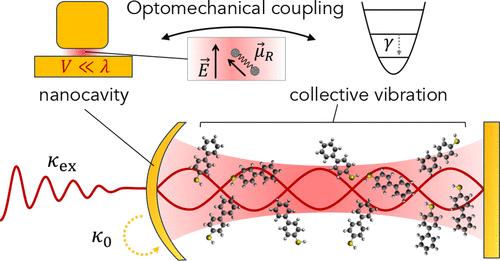分子光学的纳米空腔:其基本描述和应用
IF 6.7
1区 物理与天体物理
Q1 MATERIALS SCIENCE, MULTIDISCIPLINARY
引用次数: 0
摘要
振动拉曼散射--一个光通过非弹性散射与分子振动交换能量的过程--最基本的描述是在量子框架中,光和振动都是量子化的。当拉曼散射体被嵌入一个质子纳米腔内时,就像在一些充分受控的表面增强拉曼散射(SERS)实施方案中一样,耦合系统实现了一个光机械腔,在这个腔内,相干和参数放大的光振动相互作用成为振动状态工程和纳米级非线性光学的资源。本视角旨在阐明分子空腔光机械学(McOM)领域使用的语言和参数与其传统的 "宏观 "对应物之间的联系,并总结迄今为止在分子空腔光机械学领域取得的主要成果以及最紧迫的实验和理论挑战。我们的目标是使分子腔光学力学的理论框架能够为整个 SERS 和纳米光子学界实际使用。虽然品质因数(Q)和模式体积(V)基本上描述了纳米空腔在增强光-物质相互作用方面的性能,但我们指出光-空腔耦合效率(η)和光机械合作度(C𝒞C)是分子光机械学的关键参数。为了说明这些量的重要性,我们研究了用分子振动观测光机械诱导的透明度的可行性--这种测量可以直接估算光机械合作度。本文章由计算机程序翻译,如有差异,请以英文原文为准。

Nanocavities for Molecular Optomechanics: Their Fundamental Description and Applications
Vibrational Raman scattering─a process where light exchanges energy with a molecular vibration through inelastic scattering─is most fundamentally described in a quantum framework where both light and vibration are quantized. When the Raman scatterer is embedded inside a plasmonic nanocavity, as in some sufficiently controlled implementations of surface-enhanced Raman scattering (SERS), the coupled system realizes an optomechanical cavity where coherent and parametrically amplified light–vibration interaction becomes a resource for vibrational state engineering and nanoscale nonlinear optics. The purpose of this Perspective is to clarify the connection between the languages and parameters used in the fields of molecular cavity optomechanics (McOM) versus its conventional, “macroscopic” counterpart and to summarize the main results achieved so far in McOM and the most pressing experimental and theoretical challenges. We aim to make the theoretical framework of molecular cavity optomechanics practically usable for the SERS and nanoplasmonics community at large. While quality factors (Q) and mode volumes (V) essentially describe the performance of a nanocavity in enhancing light-matter interaction, we point to the light-cavity coupling efficiencies (η) and optomechanical cooperativities (C𝒞 ) as the key parameters for molecular optomechanics. As an illustration of the significance of these quantities, we investigate the feasibility of observing optomechanically induced transparency with a molecular vibration─a measurement that would allow for a direct estimate of the optomechanical cooperativity.
求助全文
通过发布文献求助,成功后即可免费获取论文全文。
去求助
来源期刊

ACS Photonics
NANOSCIENCE & NANOTECHNOLOGY-MATERIALS SCIENCE, MULTIDISCIPLINARY
CiteScore
11.90
自引率
5.70%
发文量
438
审稿时长
2.3 months
期刊介绍:
Published as soon as accepted and summarized in monthly issues, ACS Photonics will publish Research Articles, Letters, Perspectives, and Reviews, to encompass the full scope of published research in this field.
 求助内容:
求助内容: 应助结果提醒方式:
应助结果提醒方式:


